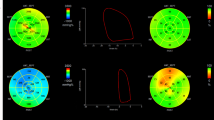Abstract
Background
Elevated lung-heart ratio (LHR) and transient ischemic dilation (TID) have been identified as markers of severe coronary artery disease after both exercise and pharmacologic stress testing. We have previously demonstrated a very weak correlation between elevated LHR and TID after exercise, which suggests that they reflect different pathophysiologic manifestations of coronary disease. Because the physiology of pharmacologic vasodilation with dipyridamole is significantly different than that of physical exercise, we undertook this study to evaluate the relationship between elevated LHR and TID after pharmacologic stress testing with dipyridamole.
Methods and Results
We identified 1129 consecutive patients who underwent pharmacologic stress imaging with dipyridamole and thallium 201. LHR and a dilation index were calculated and compared with each other and with relevant clinical parameters. Echocardiographic parameters were also compared in a subset of 475 patients who had echocardiography within 2 weeks of pharmacologic stress testing. There was no significant correlation between elevated LHR and TID despite the fact that both were associated with more severe thallium stress and redistribution scores. Patients with elevated LHR were more likely to have a history of myocardial infarction and coronary artery bypass grafting and to have lower ejection fraction. Patients with TID were more likely to have a positive electrocardiographic response (15% vs 7%, P = .0003), which was not seen in patients with elevated LHR (11% vs 8%, P = .23).
Conclusions
Although both elevated LHR and TID were associated with more severe coronary disease, they have no significant correlation. Patients with elevated LHR are more likely to have a history of myocardial infarction or coronary artery bypass grafting, a larger left ventricle, and lower ejection fraction. Our results support the hypothesis that TID is due to diffuse subendocardial hypoperfusion and represents a different pathophysiologic response to ischemia than elevated LHR.
Similar content being viewed by others
References
Josephson MA, Brown BG, Hecht HS, Hopkins J, Pierce CD, Petersen RB. Noninvasive detection and localization of coronary stenoses in patients: comparison of resting dipyridamole and exercise thallium-201 myocardial perfusion imaging. Am Heart J 1982; 103: 1008–18.
Gupta NC, Esterbrooks DJ, Hilleman DE, Mohiuddin SM. Comparison of adenosine and exercise thallium-201 single-photon emission computed tomography (SPECT) myocardial perfusion imaging. The GE SPECT Multicenter Adenosine Study Group. J Am Coll Cardiol 1992; 19: 248–57.
Bingham JB, McKusick KA, Strauss HW, Boucher CA, Pohost GM. Influence of coronary artery disease on pulmonary uptake of thallium-201. Am J Cardiol 1980; 46: 821–6.
Boucher CA, Zir LM, Beller GA, Okada RD, McKusick KA, Strauss HW, et al. Increased lung uptake of thallium-201 during exercise myocardial imaging: clinical, hemodynamic and angiographic implications in patients with coronary artery disease. Am J Cardiol 1980; 46: 189–96.
Kushner FG, Okada RD, Kirshenbaum HD, Boucher CA, Strauss HW, Pohost GM. Lung thallium-201 uptake after stress testing in patients with coronary artery disease. Circulation 1981; 63: 341–7.
Stolzenberg J. Dilatation of left ventricular cavity on stress thallium scan as an indicator of ischemic disease. Clin Nucl Med 1980; 5: 289–91.
Weiss AT, Berman DS, Lew AS, Nielsen J, Potkin B, Swan HJ, et al. Transient ischemic dilation of the left ventricle on stress thallium-201 scintigraphy: a marker of severe and extensive coronary artery disease. J Am Coll Cardiol 1987; 9: 752–9.
Canhasi B, Dae M, Botvinick E, Lanzer P, Schechtmann N, Faulkner D, et al. Interaction of “supplementary” scintigraphic indicators of ischemia and stress electrocardiography in the diagnosis of multivessel coronary disease. J Am Coll Cardiol 1985; 6: 581–8.
Martinez EE, Horowitz SF, Castello HJ, Castiglioni ML, Carvalho AC, Almeida DR, et al. Lung and myocardial thallium-201 kinetics in resting patients with congestive heart failure: correlation with pulmonary capillary wedge pressure. Am Heart J 1992; 123: 427–32.
Hansen CL, Sangrigoli R, Nkadi E, Kramer M. Comparison of pulmonary uptake with transient cavity dilation after exercise thallium-201 perfusion imaging. J Am Coll Cardiol 1999; 33: 1323–7.
Kaul S, Chesler DA, Boucher CA, Okada RD. Quantitative aspects of myocardial perfusion imaging. Semin Nucl Med 1987; 17: 131–44.
Rosner B. Fundamentals of biostatistics. Belmont (CA): Duxbury Press; 1990. p. 502–3.
Chouraqui P, Rodrigues EA, Berman DS, Maddahi J. Significance of dipyridamole-induced transient dilation of the left ventricle during thallium-201 scintigraphy in suspected coronary artery disease. Am J Cardiol 1990; 66: 689–94.
Lette J, Lapointe J, Waters D, Cerino M, Picard M, Gagnon A. Transient left ventricular cavitary dilation during dipyridamole-thallium imaging as an indicator of severe coronary artery disease. Am J Cardiol 1990; 66: 1163–70.
Takeishi Y, Tono-oka I, Ikeda K, Komatani A, Tsuiki K, Yasui S. Dilatation of the left ventricular cavity on dipyridamole thallium-201 imaging: a new marker of triple-vessel disease. Am Heart J 1991; 121: 466–75.
McClellan JR, Travin MI, Herman SD, Baron JI, Golub RJ, Gallagher JJ, et al. Prognostic importance of scintigraphic left ventricular cavity dilation during intravenous dipyridamole technetium-99m sestamibi myocardial tomographic imaging in predicting coronary events. Am J Cardiol 1997; 79: 600–5.
Villanueva FS, Kaul S, Smith WH, Watson DD, Varma SK, Beller GA. Prevalence and correlates of increased lung/heart ratio of thallium-201 during dipyridamole stress imaging for suspected coronary artery disease. Am J Cardiol 1990; 66: 1324–8.
Meerdink DJ, Okada RD, Leppo JA. The effect of dipyridamole on transmural blood flow gradients. Chest 1989; 96: 400–5.
Author information
Authors and Affiliations
Rights and permissions
About this article
Cite this article
Hansen, C.L., Cen, P., Sanchez, B. et al. Comparison of pulmonary uptake with transient cavity dilation after dipyridamole Tl-201 perfusion imaging. J Nucl Cardiol 9, 47–51 (2002). https://doi.org/10.1067/mnc.2002.118695
Received:
Accepted:
Issue Date:
DOI: https://doi.org/10.1067/mnc.2002.118695




